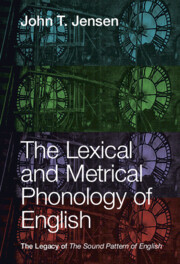Book contents
- The Lexical and Metrical Phonology of English
- The Lexical and Metrical Phonology of English
- Copyright page
- Contents
- Figures
- Preface
- Chapter 1 Theories of Phonology
- Chapter 2 Segmental Phonology
- Chapter 3 Syllables and Moras
- Chapter 4 English Stress
- Chapter 5 Prosodic Phonology
- Chapter 6 Lexical Phonology: The Cyclic Rules
- Chapter 7 Word-Level Phonology
- Chapter 8 Further Issues in Phonological Theory
- References
- Index
Chapter 5 - Prosodic Phonology
Published online by Cambridge University Press: 18 June 2022
- The Lexical and Metrical Phonology of English
- The Lexical and Metrical Phonology of English
- Copyright page
- Contents
- Figures
- Preface
- Chapter 1 Theories of Phonology
- Chapter 2 Segmental Phonology
- Chapter 3 Syllables and Moras
- Chapter 4 English Stress
- Chapter 5 Prosodic Phonology
- Chapter 6 Lexical Phonology: The Cyclic Rules
- Chapter 7 Word-Level Phonology
- Chapter 8 Further Issues in Phonological Theory
- References
- Index
Summary
The use of prosodic categories gives a clearer understanding of the intonation of utterancesthan the syntactic structure that was assumed in SPE. The prosodic hierarchy includes eight categories from the highest (the phonological utterance)through the intermediate cateories (intonation phrase, phonological phrase, clitic group, phonological word, foot, syllable) to the lowest (the mora). Each unit consists exclusively of units of the next lower category, though certain derived structures are possible with nesting, as when a syllable is adjoined to a foot. In that case the original foot is a constituent of the derived larger foot and a sister to the adjoined syllable. Exemplification of segmental rules that apply in terms of each prosodic category from English and other languages. The three highest units can sometimes be restructured, either broken into smaller units or combined into a larger unit. Summary of the postlexical rules.
Keywords
- Type
- Chapter
- Information
- The Lexical and Metrical Phonology of EnglishThe Legacy of the Sound Pattern of English, pp. 184 - 234Publisher: Cambridge University PressPrint publication year: 2022

